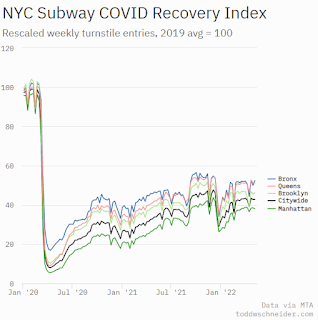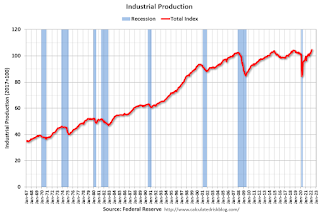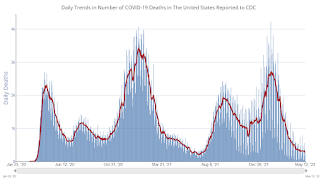by Calculated Risk on 5/16/2022 09:32:00 AM
Monday, May 16, 2022
Housing Inventory May 16th Update: Inventory UP 1.5% Year-over-Year
Altos reports inventory is up year-over-year!
Inventory usually declines in the winter, and then increases in the spring. Inventory bottomed seasonally at the beginning of March 2022 and is now up 32% since then.

This inventory graph is courtesy of Altos Research.
Inventory is still very low. Compared to the same week in 2021, inventory is up 1.5% from 314 thousand, however compared to the same week in 2020, and inventory is down 56.4% from 729 thousand. Compared to 3 years ago, inventory is down 65.2% from 915 thousand.
1. The seasonal bottom (happened on March 4th for Altos) ✅
2. Inventory up year-over-year (happened on May 13th for Altos) ✅
3. Inventory up compared to two years ago (currently down 56% according to Altos)
4. Inventory up compared to 2019 (currently down 65%).
Four High Frequency Indicators for the Economy
by Calculated Risk on 5/16/2022 08:15:00 AM
These indicators are mostly for travel and entertainment. It is interesting to watch these sectors recover as the pandemic subsides. Note: Apple has discontinued "Apple mobility", and restaurant traffic is mostly back to normal.
The TSA is providing daily travel numbers.
This data is as of May 15th.
 Click on graph for larger image.
Click on graph for larger image.This data shows the 7-day average of daily total traveler throughput from the TSA for 2019 (Light Blue), 2020 (Black), 2021 (Blue) and 2022 (Red).
The dashed line is the percent of 2019 for the seven-day average.
The 7-day average is down 10.7% from the same day in 2019 89.3% of 2019). (Dashed line)
 This data shows domestic box office for each week and the median for the years 2016 through 2019 (dashed light blue).
This data shows domestic box office for each week and the median for the years 2016 through 2019 (dashed light blue). Note that the data is usually noisy week-to-week and depends on when blockbusters are released.
Movie ticket sales were at $277 million last week, up about 17% from the median for the week due to strong sales for Dr Strange.
 This graph shows the seasonal pattern for the hotel occupancy rate using the four-week average.
This graph shows the seasonal pattern for the hotel occupancy rate using the four-week average. The red line is for 2022, black is 2020, blue is the median, and dashed light blue is for 2021. Dashed purple is 2019 (STR is comparing to a strong year for hotels).
This data is through May 7th. The occupancy rate was down 6.1% compared to the same week in 2019.
Notes: Y-axis doesn't start at zero to better show the seasonal change.
Here is some interesting data on New York subway usage (HT BR).
 This graph is from Todd W Schneider.
This graph is from Todd W Schneider. This data is through Friday, May 13th.
He notes: "Data updates weekly from the MTA’s public turnstile data, usually on Saturday mornings".
Sunday, May 15, 2022
Sunday Night Futures
by Calculated Risk on 5/15/2022 07:24:00 PM
Weekend:
• Schedule for Week of May 15, 2022
Monday:
• At 8:30 AM ET, The New York Fed Empire State manufacturing survey for May. The consensus is for a reading of 17.0, down from 24.6.
From CNBC: Pre-Market Data and Bloomberg futures S&P 500 are up 12 and DOW futures are up 84 (fair value).
Oil prices were up over the last week with WTI futures at $111.19 per barrel and Brent at $112.21 per barrel. A year ago, WTI was at $66 and Brent was at $70 - so WTI oil prices are up 70% year-over-year.
Here is a graph from Gasbuddy.com for nationwide gasoline prices. Nationally prices are at $4.46 per gallon. A year ago prices were at $3.02 per gallon, so gasoline prices are up $1.44 per gallon year-over-year.
Q2 GDP Forecasts
by Calculated Risk on 5/15/2022 12:28:00 PM
From BofA:
We forecast 2.7% GDP growth this year given wealth and liquidity remain supportive. We expect growth to slow to 1.8% next year, with a sequential slowdown to just 1% by 4Q as a restrictive Fed takes its toll. [Q2 3.5% May 13 estimate]From Goldman:
emphasis added
We are downgrading our Q2 GDP tracking estimate by 0.4pp to +2.5% (qoq ar), below consensus of +3.0%. The downgrade to US auto production schedules over the last month and the pickup in core goods inflation in the CPI and PPI reports is consistent with supply chain disruptions from the Russia-Ukraine War and the China covid lockdowns. [May 14 estimate]And from the Altanta Fed: GDPNow
The GDPNow model estimate for real GDP growth (seasonally adjusted annual rate) in the second quarter of 2022 is 1.8 percent on May 9, down from 2.2 percent on May 4. [May 9 estimate]
Saturday, May 14, 2022
Real Estate Newsletter Articles this Week
by Calculated Risk on 5/14/2022 02:11:00 PM
At the Calculated Risk Real Estate Newsletter this week:
• What will Happen with House Prices?
• Realtor.com Reports Weekly Inventory Up Slightly Year-over-year
• 2nd Look at Local Housing Markets in April
• Mortgage Originations by Credit Score and Age
• Homebuilder Comments in April: “Demand is slowing", "Investors pulling back" Clear signs of a market shift
• Housing Market: Where it's at. Where it's going.
This is usually published 4 to 6 times a week and provides more in-depth analysis of the housing market.
The blog will continue as always!
You can subscribe at https://calculatedrisk.substack.com/
Schedule for Week of May 15, 2022
by Calculated Risk on 5/14/2022 08:11:00 AM
The key reports this week are April Retail Sales, Housing Starts and Existing Home Sales.
For manufacturing, April Industrial Production, and the May NY and Philly Fed manufacturing surveys will be released.
Fed Chair Powell speaks on Tuesday.
Note: The Census Bureau is expected to release "National, State, and County housing units" from the 2020 Census sometime in May.
8:30 AM: The New York Fed Empire State manufacturing survey for May. The consensus is for a reading of 17.0, down from 24.6.
 8:30 AM ET: Retail sales for April is scheduled to be released. The consensus is for 0.8% increase in retail sales.
8:30 AM ET: Retail sales for April is scheduled to be released. The consensus is for 0.8% increase in retail sales.This graph shows retail sales since 1992. This is monthly retail sales and food service, seasonally adjusted (total and ex-gasoline).
Retail sales were up 0.7% in March.
 9:15 AM: The Fed will release Industrial Production and Capacity Utilization for April.
9:15 AM: The Fed will release Industrial Production and Capacity Utilization for April.This graph shows industrial production since 1967.
The consensus is for a 0.4% increase in Industrial Production, and for Capacity Utilization to increase to 78.5%.
10:00 AM: The May NAHB homebuilder survey. The consensus is for a reading of 75 down from 77 last month. Any number above 50 indicates that more builders view sales conditions as good than poor.
2:00 PM: Discussion, Fed Chair Jerome H. Powell, Conversation with Nick Timiraos, At the Wall Street Journal Future of Everything Festival, New York, New York
7:00 AM ET: The Mortgage Bankers Association (MBA) will release the results for the mortgage purchase applications index.
 8:30 AM ET: Housing Starts for April.
8:30 AM ET: Housing Starts for April. This graph shows single and total housing starts since 1968.
The consensus is for 1.773 million SAAR, down from 1.793 million SAAR in March.
During the day: The AIA's Architecture Billings Index for April (a leading indicator for commercial real estate).
8:30 AM: The initial weekly unemployment claims report will be released. The consensus is for 210 thousand up from 203 thousand last week.
8:30 AM: the Philly Fed manufacturing survey for May. The consensus is for a reading of 16.7, down from 17.6.
 10:00 AM: Existing Home Sales for April from the National Association of Realtors (NAR). The consensus is for 5.62 million SAAR, down from 5.77 million.
10:00 AM: Existing Home Sales for April from the National Association of Realtors (NAR). The consensus is for 5.62 million SAAR, down from 5.77 million.The graph shows existing home sales from 1994 through the report last month.
10:00 AM: State Employment and Unemployment (Monthly) for April 2022
Friday, May 13, 2022
COVID May 13, 2022: New Cases and Hospitalizations Increasing
by Calculated Risk on 5/13/2022 09:11:00 PM
On COVID (focus on hospitalizations and deaths):
| COVID Metrics | ||||
|---|---|---|---|---|
| Now | Week Ago | Goal | ||
| Percent fully Vaccinated | 66.4% | --- | ≥70.0%1 | |
| Fully Vaccinated (millions) | 220.5 | --- | ≥2321 | |
| New Cases per Day3🚩 | 87,382 | 67,403 | ≤5,0002 | |
| Hospitalized3🚩 | 14,604 | 12,795 | ≤3,0002 | |
| Deaths per Day3 | 272 | 322 | ≤502 | |
| 1 Minimum to achieve "herd immunity" (estimated between 70% and 85%). 2my goals to stop daily posts, 37-day average for Cases, Currently Hospitalized, and Deaths 🚩 Increasing 7-day average week-over-week for Cases, Hospitalized, and Deaths ✅ Goal met. | ||||
 Click on graph for larger image.
Click on graph for larger image.This graph shows the daily (columns) and 7-day average (line) of deaths reported.
Average daily deaths bottomed in July 2021 at 214 per day.
Hotels: Occupancy Rate Down 6.1% Compared to Same Week in 2019
by Calculated Risk on 5/13/2022 02:31:00 PM
U.S. hotel occupancy declined from the previous week, while average daily rate (ADR) increased slightly, according to STR‘s latest data through May 7.The following graph shows the seasonal pattern for the hotel occupancy rate using the four-week average.
May 1-7, 2022 (percentage change from comparable week in 2019*):
• Occupancy: 63.9% (-6.1%)
• verage daily rate (ADR): $147.24 (+12.0%)
• evenue per available room (RevPAR): $94.10 (+5.1%)
*Due to the pandemic impact, STR is measuring recovery against comparable time periods from 2019.
emphasis added
 Click on graph for larger image.
Click on graph for larger image.The red line is for 2022, black is 2020, blue is the median, and dashed light blue is for 2021. Dashed purple is 2019 (STR is comparing to a strong year for hotels).
What will Happen with House Prices?
by Calculated Risk on 5/13/2022 12:33:00 PM
Today, in the Calculated Risk Real Estate Newsletter: What will Happen with House Prices?
Excerpt:
Now let's look at the year-over-year change for the same period in real terms (inflation adjusted using CPI-less shelter).
Note that in real terms, house prices declined during the stall periods in 1982 and 1991. In the early ‘80s, real prices declined 11% from the peak, even though nominal prices only declined slightly. Homeowners are only concerned with nominal prices, so they didn’t notice the real price decline.
In the early ‘90s, real prices decline almost 14% even though nominal prices declined 3%. Note that real prices were flat for several years in the mid-‘90s.
During the housing bust, real prices declined 35% compared to a 26% decline in nominal prices (this was a low inflation period).
...
The data seems to argue for the slow house price growth scenario, but my view is the most likely scenario is house prices will stall in nominal terms and decline in real terms. I’ve been looking at the 1978 to 1982 period for lessons, and that would suggest a stall in house prices (hopefully we avoid a recession).
Unfortunately, I don’t have the existing home inventory data for that period. However, my guess is the slow growth scenario would suggest inventory in the 4 to 5 months range, and the stall scenario would be close to 6 months of inventory. For the bust scenario, my guess is we’d see existing home inventory at 7+ months.
Leading Index for Commercial Real Estate "Rises in April"
by Calculated Risk on 5/13/2022 08:51:00 AM
From Dodge Data Analytics: Dodge Momentum Index Rises in April
The Dodge Momentum Index (DMI) moved 6% higher in April to 164.8 (2000=100), up from the revised March reading of 155.0. The Momentum Index, issued by Dodge Construction Network, is a monthly measure of the initial report for nonresidential building projects in planning shown to lead construction spending for nonresidential buildings by a full year. In April, the commercial component of the Momentum Index rose 9%, while the institutional component moved 2% higher.
With the gain in April, the Dodge Momentum Index was just 5% shy of the all-time high set in the fall of 2021. The main impetus behind this trend is the commercial sector, which has been driven by a growing number of data center, warehouse and hotel projects entering the planning queue. The institutional component has made moderate improvements as well, as more education, healthcare and recreation projects begin the planning process. On a year-over-year basis, the Momentum Index was 17% higher than in April 2021. The commercial component was 15% higher, while the institutional component was 22% higher than a year ago.
emphasis added
 Click on graph for larger image.
Click on graph for larger image.This graph shows the Dodge Momentum Index since 2002. The index was at 164.8 in April, up from 155.0 in March.
According to Dodge, this index leads "construction spending for nonresidential buildings by a full year". This index suggested a decline in Commercial Real Estate construction through most of 2021, but a solid pickup this year and into 2023.



